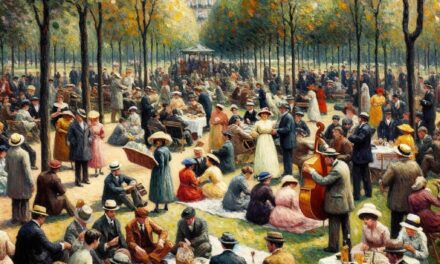Surrealism, an avant-garde artistic and literary movement, emerged in the early 20th century as a response to the profound devastation and disillusionment wrought by the First World War. Originating in Paris during the 1920s, Surrealism sought to explore the unconscious mind and challenge conventional notions of reality. The movement was heavily influenced by Sigmund Freud’s theories of psychoanalysis and aimed to unleash the creative potential of the subconscious through techniques such as automatic writing and drawing.
Surrealist artists and writers, including André Breton, Salvador Dalí, and René Magritte, produced works characterised by unexpected juxtapositions, dreamlike imagery, and a rejection of logical reasoning. Their creations often blurred the boundaries between reality and fantasy, inviting viewers and readers to question their perceptions and embrace the irrational aspects of human experience.
Summary
- Surrealism originated in the 1920s as a cultural movement in Paris, influenced by Dadaism and the psychoanalytic theories of Sigmund Freud.
- Key figures in the Surrealist movement include André Breton, Salvador Dalí, Max Ernst, and René Magritte, who sought to unlock the creative potential of the unconscious mind.
- Surrealist techniques such as automatic writing, exquisite corpse, and frottage were used to access the subconscious, while manifestos like Breton’s “Surrealist Manifesto” outlined the movement’s principles.
- Surrealism in art and literature is characterised by dreamlike imagery, unexpected juxtapositions, and a rejection of rationality, with notable works including Dalí’s “The Persistence of Memory” and Breton’s “Nadja”.
- Surrealism in film and theatre is exemplified by Luis Buñuel’s “Un Chien Andalou” and the Theatre of the Absurd, which challenged traditional storytelling and embraced the irrational and absurd.
- The influence of Surrealism on contemporary culture can be seen in fashion, advertising, and popular media, as well as in the works of artists like David Lynch and writers like Haruki Murakami.
- Criticisms and controversies surrounding Surrealism include accusations of misogyny, exploitation of mental illness, and the movement’s failure to address political and social issues.
The term “surrealism” was coined by the French writer Guillaume Apollinaire in 1917, but it was the poet André Breton who would become the movement’s leading figure. In 1924, Breton published the Surrealist Manifesto, which outlined the principles and goals of the movement. Surrealism sought to unlock the creative potential of the unconscious mind, tapping into the realm of dreams, fantasies, and irrational thoughts.
The movement was heavily influenced by the psychoanalytic theories of Sigmund Freud, particularly his ideas about the unconscious and the role of dreams in revealing hidden desires and fears.
The Roots of Surrealism
Surrealism built upon these ideas, but with a more focused exploration of the unconscious mind and its creative potential.
A Global Phenomenon
The movement quickly spread beyond France, attracting artists and writers from around the world who were drawn to its revolutionary ideas and techniques.
A Lasting Legacy
Surrealism became a powerful force in shaping the cultural landscape of the 20th century, influencing not only art and literature but also film, theatre, and popular culture.
Key Figures in the Surrealist Movement

André Breton is widely regarded as the founder and leader of the Surrealist movement. His 1924 Surrealist Manifesto laid out the principles and goals of the movement, advocating for the liberation of the unconscious mind and the rejection of rational thought. Breton was a prolific writer and poet, and his work played a crucial role in defining the aesthetic and philosophical underpinnings of Surrealism.
He also played a key role in organizing Surrealist exhibitions and events, bringing together artists and writers who shared his vision. Another influential figure in the Surrealist movement was Salvador Dalí, whose eccentric personality and groundbreaking artwork made him one of the most famous Surrealist artists. Dalí’s paintings often featured bizarre and dreamlike imagery, exploring themes of sexuality, religion, and identity.
His iconic work “The Persistence of Memory” is a prime example of Surrealist art, with its melting clocks and distorted landscapes. Dalí’s flamboyant persona and controversial public statements made him a polarizing figure within the movement, but his impact on Surrealist art cannot be overstated. Other key figures in the Surrealist movement include Max Ernst, René Magritte, Man Ray, Leonora Carrington, and Frida Kahlo.
Each of these artists brought their own unique perspectives and techniques to Surrealism, contributing to its rich and diverse body of work. Their paintings, sculptures, photographs, and writings challenged traditional notions of reality and representation, pushing the boundaries of artistic expression and creativity.
Surrealist Techniques and Manifestos
Surrealism was defined by its innovative techniques and methods, which aimed to access the unconscious mind and unleash its creative potential. One of the most famous techniques associated with Surrealism is automatic writing, a practice in which writers would allow their thoughts to flow freely without conscious control, tapping into their subconscious thoughts and desires. This technique was championed by André Breton and other Surrealist writers, who believed that it could reveal hidden truths and insights that were inaccessible through rational thought.
Surrealist artists also embraced techniques such as frottage (rubbing), grattage (scraping), and decalcomania (transferring paint from one surface to another), which allowed them to create unpredictable and spontaneous textures and patterns in their work. These techniques were designed to bypass conscious control and tap into the unconscious mind, producing images that were strange, dreamlike, and enigmatic. In addition to these artistic techniques, Surrealism was also defined by its manifestos, which outlined the movement’s principles and goals.
In addition to Breton’s 1924 Surrealist Manifesto, there were several other manifestos published by Surrealist artists and writers throughout the 1920s and 1930s. These manifestos articulated the movement’s commitment to radical experimentation, anti-rationalism, and the liberation of the imagination. They also addressed political and social issues, advocating for revolutionary change and the rejection of bourgeois values.
Surrealism in Art and Literature
Surrealism had a profound impact on both visual art and literature, producing some of the most iconic works of the 20th century. In painting, Surrealist artists sought to depict dreamlike landscapes, bizarre creatures, and uncanny juxtapositions that defied conventional notions of reality. Salvador Dalí’s melting clocks, René Magritte’s floating bowler hats, and Max Ernst’s collages are just a few examples of the striking imagery produced by Surrealist artists.
These works challenged viewers to question their perceptions of reality and embrace the irrational and fantastical. In literature, Surrealist writers experimented with language and narrative structure to create works that were dreamlike, disjointed, and emotionally charged. André Breton’s novel “Nadja” is a prime example of Surrealist literature, blending autobiography with fiction to create a haunting portrait of love and madness.
Other notable Surrealist writers include Paul Éluard, Louis Aragon, and Antonin Artaud, whose works pushed the boundaries of traditional storytelling and embraced the power of the unconscious mind. Surrealism also had a significant impact on poetry, with poets such as Paul Éluard and Robert Desnos using language in innovative ways to evoke dreamlike imagery and emotions. Their poems often featured unexpected juxtapositions, startling metaphors, and fragmented syntax that challenged readers to engage with language in new and unexpected ways.
Surrealism in Film and Theatre

Groundbreaking Films
In film, directors such as Luis Buñuel and Salvador Dalí collaborated on “Un Chien Andalou” (1929) and “L’Age d’Or” (1930), two seminal works that embraced dream logic and irrationality to create provocative and unsettling narratives. These films featured shocking imagery and disjointed narratives that defied easy interpretation, reflecting the influence of Surrealist ideas on cinematic storytelling.
Experimental Theatre
In theatre, Surrealism inspired experimental playwrights such as Antonin Artaud, whose “Theatre of Cruelty” sought to create immersive experiences that bypassed rational thought and tapped into primal emotions. Artaud’s plays often featured non-linear narratives, ritualistic performances, and confrontational staging that challenged audiences to engage with theatre in new and unexpected ways.
Avant-Garde Theatre Groups
Surrealist ideas also influenced avant-garde theatre groups such as The Living Theatre in New York City, which embraced radical experimentation in performance art and sought to break down barriers between actors and audiences. These groups drew inspiration from Surrealist techniques such as automatic writing and improvisation to create immersive theatrical experiences that challenged traditional notions of storytelling and performance.
The Influence of Surrealism on Contemporary Culture
Surrealism’s impact on contemporary culture can be seen in a wide range of artistic disciplines, from fashion to advertising to music. The movement’s emphasis on irrationality, dream imagery, and subversion of traditional norms has inspired countless artists to push boundaries and challenge conventional thinking. In fashion, designers such as Elsa Schiaparelli drew inspiration from Surrealist art to create bold and imaginative clothing that defied traditional notions of beauty and femininity.
Schiaparelli’s collaborations with artists such as Salvador Dalí resulted in iconic designs that featured whimsical motifs such as lobster prints, shoe hats, and trompe l’oeil embroidery. Surrealism has also had a significant impact on advertising, with brands using dreamlike imagery and unexpected juxtapositions to create memorable campaigns that capture viewers’ attention. The influence of Surrealism can be seen in advertising campaigns for products ranging from perfume to automobiles, where unexpected visuals and playful narratives are used to create a sense of wonder and intrigue.
In music, artists such as The Beatles, David Bowie, Björk, and Radiohead have drawn inspiration from Surrealist ideas to create innovative sounds and visuals that challenge listeners’ perceptions of reality. These musicians have embraced unconventional song structures, experimental instrumentation, and surrealistic imagery to create music that is both thought-provoking and emotionally resonant.
Criticisms and Controversies Surrounding Surrealism
While Surrealism has had a profound impact on art and culture, it has also faced criticism for its perceived elitism, misogyny, and lack of political engagement. Critics have argued that some Surrealist artists perpetuated sexist stereotypes through their depictions of women as passive objects of desire or irrational creatures. The movement’s emphasis on irrationality has also been criticised for its potential to undermine social justice causes by rejecting rational discourse.
Additionally, some critics have accused Surrealism of being too focused on individual expression at the expense of collective action. They argue that the movement’s emphasis on personal liberation through artistic experimentation may have overshadowed broader social or political goals. Others have criticised Surrealism for its perceived detachment from real-world issues such as war, poverty, and inequality.
Despite these criticisms, Surrealism remains a powerful force in shaping contemporary culture through its emphasis on creativity, imagination, and subversion of traditional norms. The movement’s legacy continues to inspire artists across disciplines to challenge conventions and push boundaries in pursuit of new forms of expression.
If you are interested in learning more about different art movements, you may want to check out this article on Cubism. This avant-garde movement, pioneered by artists such as Pablo Picasso and Georges Braque, revolutionised the way we perceive art and reality. Just like Surrealism, Cubism challenged traditional artistic conventions and sought to depict the world in a new and innovative way. Understanding the context and characteristics of different art movements can provide valuable insight into the evolution of artistic expression.
FAQs
What is Surrealism?
Surrealism is an artistic and literary movement that emerged in the early 20th century, focusing on expressing the subconscious mind and exploring the power of imagination. It sought to challenge the rational and logical aspects of society and art, embracing the irrational and the dreamlike.
Who were the key figures of Surrealism?
Some of the key figures of Surrealism include André Breton, Salvador Dalí, Max Ernst, René Magritte, and Joan Miró. André Breton, a French writer and poet, is often considered the founder of the Surrealist movement.
What are the main characteristics of Surrealist art?
Surrealist art often features dreamlike imagery, unexpected juxtapositions, and a sense of the irrational. It frequently explores themes of the unconscious mind, sexuality, and the human psyche. Surrealist artists often used techniques such as automatic drawing and collage to tap into their subconscious.
How did Surrealism influence other art forms?
Surrealism had a significant impact on literature, film, and theatre, as well as visual arts. It inspired the development of new techniques and approaches, such as stream-of-consciousness writing and experimental filmmaking. Surrealist ideas also influenced the development of pop art and abstract expressionism.
What is the legacy of Surrealism?
Surrealism continues to influence contemporary art and culture. Its emphasis on the power of the imagination and the subconscious has had a lasting impact on artistic expression. Surrealist ideas have also influenced fields such as psychology and philosophy, shaping our understanding of the human mind and creativity.




